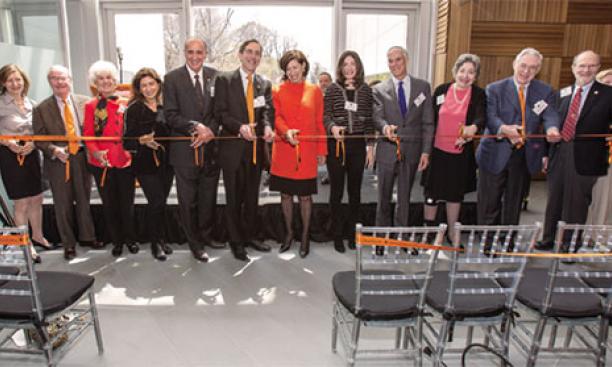

Some of the most exciting moments of my tenure as provost came in 2004, when professors Jonathan Cohen of the Department of Psychology and David Tank of the Department of Molecular Biology visited my office to make very persuasive cases for why Princeton needed to do something big and impactful in neuroscience.
I recalled those conversations as I joined professors Cohen and Tank, and other Princetonians and friends at the April 25 dedication for the marvelous new facilities of the Princeton Neuroscience Institute (PNI) and Peretsman Scully Hall, home of the psychology department. The decade-long journey to that day was led by my predecessor, Shirley M. Tilghman. She championed the bold vision that Princeton should be a leader in tackling one of the greatest scientific challenges of our time — understanding the mechanisms of the brain to unlock the mysteries of how we think, feel, and make decisions, and to help develop treatments for devastating illnesses ranging from addictions to autism to Alzheimer’s disease. President Tilghman, along with our faculty, trustees, and alumni supporters, recognized that Princeton was in a distinctive position to drive advances in the field, with world-class researchers and teachers who thrive on interdisciplinary collaboration and a tradition of theoretical and computational strengths not found in other leading neuroscience programs.
Over the past decade, our neuroscientists and psychologists — along with biologists, mathematicians, physicists, engineers, and computer scientists — have done spectacular work. We are fortunate to have an outstanding group of faculty and students who are united by their shared interests in systems neuroscience, and by their strong and unique emphasis on quantitation and theory. I am thrilled that both PNI, established in 2005 under the co-direction of professors Cohen and Tank, and the psychology department, chaired by Professor Deborah Prentice, now have such wonderful labs, offices, classrooms, and equipment. As Professor Cohen remarked at the dedication, the new complex represents “the formation of a truly seamless community of research and education under one roof that spans from the molecular to the mental, and has made us the envy of the field.” That field will, he added, “have a profound impact on virtually all of human discourse, from medicine and the design of intelligent machines to philosophy and the law.”
Professor Tank pointed out that student interest was a major catalyst in the development of neuroscience at Princeton. The neuroscience certificate program has attracted students from 23 different concentrations, with the number of certificate candidates rising from two in 2002 to 33 in 2008 to 50 this year — “a remarkable period of growth that shows no signs of leveling off,” he noted.
At the core of Princeton’s growth in neuroscience is our faculty. We drew upon support from Annual Giving and dedicated gifts to add six new faculty positions to PNI even before its new building opened, thereby enhancing Princeton’s already strong roster of faculty engaged in the field and expanding our interdisciplinary networks.
The quality of the people attracted to the institute is spectacular. Their research, which employs a variety of theoretical and experimental techniques, is fascinating and prize-winning. For example, Assistant Professor Yael Niv recently received a Presidential Early Career Award for Scientists and Engineers, the highest early-career honor bestowed by the U.S. government upon scientists and engineers. She leads innovative studies of the neural and computational processes underlying learning and decisionmaking, or how people choose their actions when faced with rewards or punishments. Associate Professor Carlos Brody is a Howard Hughes Medical Investigator, one of the highest honors in biomedical research. He conducts pioneering studies of how individual neurons and networks of neurons compute information needed to make decisions — illuminating the mechanisms involved in everyday choices like picking an ice cream flavor or a movie to enjoy. Doctoral student Cristina Domnisoru this fall received a Porter Ogden Jacobus Fellowship, Princeton’s top honor for graduate students, for her ambitious dissertation research on the cellular and circuit mechanisms of neural computation in a brain system that is important in navigation and memory. She hopes this work will lead to therapies for neurodegenerative and neuropsychiatric diseases.
Our new facilities will undoubtedly aid our efforts to recruit stellar faculty and graduate students to join our brilliant roster of neuroscientists. I am grateful for the alumni and friends whose generous capital gifts — made during difficult economic times — were essential to the creation of the complex and three research units within PNI: the Scully Center for the Neuroscience of Mind and Behavior; the McDonnell Center for Systems Neuroscience; and the Bezos Center for Neural Circuit Dynamics. Many more alumni also made important contributions through Annual Giving, which provided key funds for these building projects.
As we celebrate our remarkable progress in neuroscience over the past 10 years, we must also look to the future — and remain ready to address rapidly evolving needs in this critical field, which is poised to bring tremendous benefits to humanity in the generations to come.

